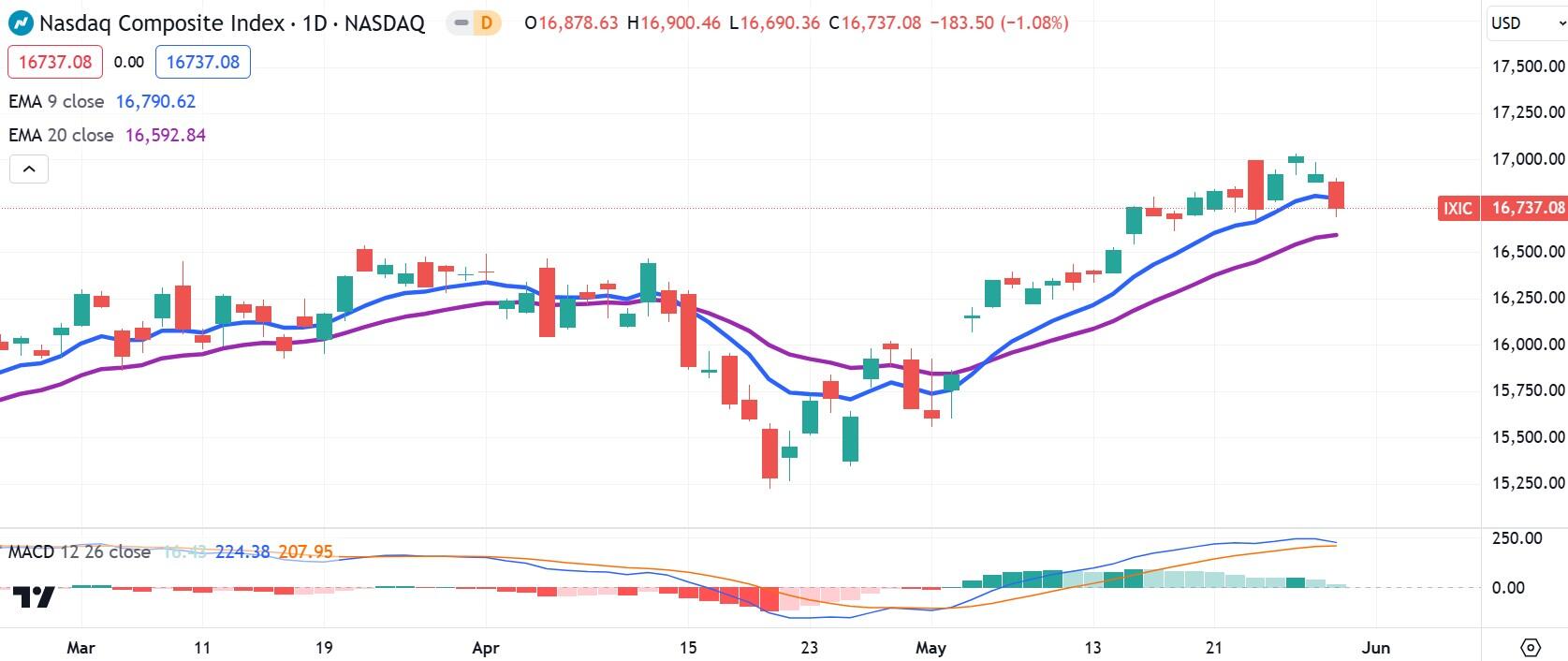- Core PCE data from the US shows monthly inflation arriving below expectations.
- Downwardly revised consumer spending data and Q1 GDP growth earlier in the week worry traders.
- UiPath and Salesforce plunge on reduced growth.
- Dell, MongoDB, CrowdStrike suffer from pessimism regarding guidance.
A number of premier tech stocks have cascaded lower late this week, providing the NASDAQ index with reason to power down.
Three tech stalwarts capsized on Thursday: CrowdStrike (CRWD), UiPath (PATH) and Salesforce (CRM).
Then on Friday, Dell (DELL) and MongoDB (MDB) plunged in the premarket following unloved earnings releases.
The overall market has been dealing with a Q1 GDP figure that was revised lower for the US economy on top of reduced data regarding consumer spending. This data would seem to align itself with ushering in Federal Reserve (Fed) interest rate cuts already, but then on Friday core Personal Consumption Expenditures (PCE) data showed core inflation drifting down to 0.2% MoM, below consensus.
The NASDAQ fell 1.08% on Thursday but gained somewhat due to the PCE release in Friday's premarket.
Stock market news: CRWD, PATH, CRM, DELL, MDB
CrowdStrike ducked 9.6% on Thursday but is rebounding somewhat in Friday’s premarket. The company announced a partnership with Cloudflare for zero-trust technology. Bulls are looking ahead to quarterly results on June 4.
UiPath beat Wall Street’s earnings and revenue consensus on Thursday but collapsed 34% after announcing an abrupt change in the CEO position. Keybanc and Bank of America both downgraded the automation software company on slower growth. Management provided guidance for revenue to rise 7.6% in 2025 rather than the 19.1% given earlier.
Salesforce (CRM) dropped 19.7% on Thursday after the purveyor of the leading customer relationship management software missed its earnings and sales consensus. Jefferies, Mizuho and Morgan Stanley all cut their price targets on the stock but gave rather optimistic outlooks for the future, chalking up the current malaise to a temporary situation. CRM’s Thursday performance was its worst in 16 years.
Dell’s sell-off was surprising. DELL shares lost more than 5% on Thursday and fell another 17% in Friday’s premarket. It missed the quarterly earnings consensus by 1% but surpassed the consensus for revenue, reaching $22.2 billion. One culprit is that the AI server backlog fell $1 billion below expectations but still sits at $3.8 billion. Another is that gross margin is expected to dip by 150 basis points in the coming quarters.
MongoDB lost more than 7% on Thursday and is down 24% in Friday’s premarket. Despite besting Wall Street consensus, MongoDB shed weight due to its Q2 outlook. Management said revenue should arrive at $462 million, below consensus of $471 million. Earnings per share is also expected to fall below consensus of $0.57, arriving between $0.46 and $0.49.
Nasdaq FAQs
The Nasdaq is a stock exchange based in the US that started out life as an electronic stock quotation machine. At first, the Nasdaq only provided quotations for over-the-counter (OTC) stocks but later it became an exchange too. By 1991, the Nasdaq had grown to account for 46% of the entire US securities’ market. In 1998, it became the first stock exchange in the US to provide online trading. The Nasdaq also produces several indices, the most comprehensive of which is the Nasdaq Composite representing all 2,500-plus stocks on the Nasdaq, and the Nasdaq 100.
The Nasdaq 100 is a large-cap index made up of 100 non-financial companies from the Nasdaq stock exchange. Although it only includes a fraction of the thousands of stocks in the Nasdaq, it accounts for over 90% of the movement. The influence of each company on the index is market-cap weighted. The Nasdaq 100 includes companies with a significant focus on technology although it also encompasses companies from other industries and from outside the US. The average annual return of the Nasdaq 100 has been 17.23% since 1986.
There are a number of ways to trade the Nasdaq 100. Most retail brokers and spread betting platforms offer bets using Contracts for Difference (CFD). For longer-term investors, Exchange-Traded Funds (ETFs) trade like shares that mimic the movement of the index without the investor needing to buy all 100 constituent companies. An example ETF is the Invesco QQQ Trust (QQQ). Nasdaq 100 futures contracts allow traders to speculate on the future direction of the index. Options provide the right, but not the obligation, to buy or sell the Nasdaq 100 at a specific price (strike price) in the future.
Many different factors drive the Nasdaq 100 but mainly it is the aggregate performance of the component companies revealed in their quarterly and annual company earnings reports. US and global macroeconomic data also contributes as it impacts on investor sentiment, which if positive drives gains. The level of interest rates, set by the Federal Reserve (Fed), also influences the Nasdaq 100 as it affects the cost of credit, on which many corporations are heavily reliant. As such the level of inflation can be a major driver too as well as other metrics which impact on the decisions of the Fed.
NASDAQ forecast
The NASDAQ tracked below the 9-day Exponential Moving Average (EMA) on Thursday, its first time since May 1. This could signify a pullback in the works, although the inflation news on Friday might lead to a rebound.
The Moving Average Convergence Divergence (MACD) indicator showcases a likely crossover that would foreshadow a downtrend as well. If a downtrend does arrive over the next week, expect the NASDAQ to find its footing between 16,000 and 16,250. This is an area where the index has spent considerable time.
A pullback would be unsurprising since the NASDAQ just reached 17,000 for the first time ever earlier this week. In other words, consolidation seems to be arriving right in line with expectations.
NASDAQ daily chart
Information on these pages contains forward-looking statements that involve risks and uncertainties. Markets and instruments profiled on this page are for informational purposes only and should not in any way come across as a recommendation to buy or sell in these assets. You should do your own thorough research before making any investment decisions. FXStreet does not in any way guarantee that this information is free from mistakes, errors, or material misstatements. It also does not guarantee that this information is of a timely nature. Investing in Open Markets involves a great deal of risk, including the loss of all or a portion of your investment, as well as emotional distress. All risks, losses and costs associated with investing, including total loss of principal, are your responsibility. The views and opinions expressed in this article are those of the authors and do not necessarily reflect the official policy or position of FXStreet nor its advertisers. The author will not be held responsible for information that is found at the end of links posted on this page.
If not otherwise explicitly mentioned in the body of the article, at the time of writing, the author has no position in any stock mentioned in this article and no business relationship with any company mentioned. The author has not received compensation for writing this article, other than from FXStreet.
FXStreet and the author do not provide personalized recommendations. The author makes no representations as to the accuracy, completeness, or suitability of this information. FXStreet and the author will not be liable for any errors, omissions or any losses, injuries or damages arising from this information and its display or use. Errors and omissions excepted.
The author and FXStreet are not registered investment advisors and nothing in this article is intended to be investment advice.
Recommended content
Editors’ Picks

EUR/USD drops below 1.0800 on Trump's 'Liberation Day'
EUR/USD is back in the red below 1.0800 in the early European morning on Wednesday as investors rush for the safe-haven US Dollar, aniticpating US President Donald Trump’s long-threatened “reciprocal” tariffs package, due to be announced at 20:00 GMT.

GBP/USD trades with caution above 1.2900, awaits Trump’s tariffs reveal
GBP/USD is trading with caution above 1.2900 early Wednesday, struggles to capitalize on the overnight bounce amid resugent haven demand for the US Dollar. Traders remain wary heading into the US 'reciprocal tariffs' announcement on "Liberation Day' at 20:00 GMT.

Gold price remains close to record high amid concerns over Trump’s reciprocal tariffs
Gold price regains positive traction amid concerns about Trump’s aggressive trade policies. Fed rate cut bets keep the USD bulls on the defensive and further benefiting the XAU/USD pair. A broadly stable risk sentiment might cap gains ahead of Trump’s tariffs announcement.

Bitcoin, Ethereum and Ripple brace for volatility amid Trump’s ‘Liberation Day’
Bitcoin price faces a slight rejection around its $85,000 resistance level on Wednesday after recovering 3.16% the previous day. Ripple follows BTC as it falls below its critical level, indicating weakness and a correction on the horizon.

Is the US economy headed for a recession?
Leading economists say a recession is more likely than originally expected. With new tariffs set to be launched on April 2, investors and economists are growing more concerned about an economic slowdown or recession.

The Best brokers to trade EUR/USD
SPONSORED Discover the top brokers for trading EUR/USD in 2025. Our list features brokers with competitive spreads, fast execution, and powerful platforms. Whether you're a beginner or an expert, find the right partner to navigate the dynamic Forex market.


